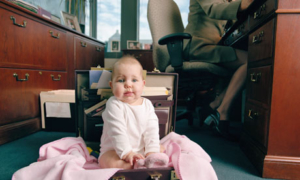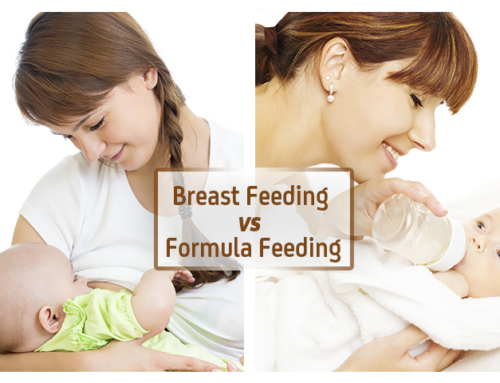Once again I find myself wanting to yell at my computer screen. It’s as if the TIME cover set off a whole new wave of hysteria and outlandish and uneducated opinions about some of the practices of attachment parenting and I find myself getting more and more frustrated by the idiocy that parades around as journalism and feminist thought. Though lately the focus has gone off breastfeeding and taken aim at the battle over the stay-at-home vs. working mom. And it’s flat-out ridiculous.
Recently I was lead to a piece written by Katha Pollitt who claims that Attachment Parenting is bad not only for women, but for children too. Her evidence? Well, none. Her opinion? Based on the work of the French “feminist” (I must put this in quotations because rarely have I seen a woman do so much harm to women’s rights that I can’t bear to use the word for her, though perhaps that’s more in line with some of the notions of popular feminism these days) Elisabeth Badinter, Ms. Pollitt decides to share why she believes “intensive, obsessive mothering” is bad for everyone, and it all comes down to the idea that to follow attachment parenting means that “Baby is King; Mom is servant”. And of course because of that, the child will grow to believe the world revolves around him/her. Once again, attachment parents are portrayed as quacks who are dismantling all the hard work women have put in before us to get us a spot in the workforce. They are ruining the very fabric of our society.
Ruining the very fabric of American society you say? You know what I think? Good. In fact, great. Ms. Pollitt and I can agree on one thing and it’s that America is, as she puts it, “famously unfriendly to mothers”, but we disagree as to the reason. She believes it’s that there’s a belief a woman’s role is at home. Sorry, Katha, but if that were the case, you’d see far more policies in place to allow women to be at home – fair wages for whoever worked, proper health care, etc.. In fact, the idea of a woman at home is so disheartening to many Americans that it’s become a topic in the current US primaries as Mitt Romney’s wife got quite a bit of grief for being a stay-at-home mom. There are articles left and right about how women lose their independence and can’t support themselves when they choose to stay at home (because the thought of accepting a relationship in which people agree to stay together and accept dependence on another, just as the other depends on them is far too outlandish). No, there’s no support for mothers because American society views their place as being in the workforce. The American economy depends upon women working, with many working for horrible wages while they struggle to find someone else to care for their children. In my mind, anything that helps turn this backwards, screwed up society on its head is a good thing.
But this isn’t about the politics of feminism and staying-at-home (that’s an entire dissertation to be honest). It’s about the completely ridiculous and asinine notion that attachment parenting practices per se are antithetical to women working.
Often people (and specifically Ms. Pollitt) comment that you can’t be a working mom while breastfeeding your child to 3 years of age, sleep with them, and wear them as a baby. They act as if these practices are entirely new – how else can you justify calling them extreme or intense? Unfortunately all of these people need a bit of a history lesson because these practices are as old as human history and even more importantly, it is because of some of these practices that mothers have been able to continue to contribute to their family and tribe. After a period of rest and time to establish breastfeeding, women around the world and historically would then return to farm, hunt or gather, watch multiple children, and perform other “work”. Babywearing allowed them to keep their infant close and comforted while doing this work. Co-sleeping allowed baby to stay safe, but also allowed for mom to have enough sleep to be functional the next day; after all, breastfeeding and tending to a baby who rouses is generally much easier when the baby is at hand and one can nurse lying down, or even sleeping. Yes, mom might have to take breaks to feed her baby from the breast, but that provides baby with the nutrition baby expects to get, filled with antibodies, nutrients, and proteins that help the brain develop as it evolved to develop, and if mom is babywearing, she may not need the break at all as many moms have figured out how to nurse “on-the-go” with baby strapped to one’s chest.
Now I know many people will point out that us Westerners no longer live in this era, so all this is moot. I disagree.
Today, although there are jobs that would be ill-suited for a woman with a baby (as there are in hunter-gatherer or more primitive societies), most of our work is less physically taxing than it is elsewhere or historically. A woman sitting at a desk is fully capable of doing her work with a baby strapped to her. In fact, those early moths are ideally suited to taking your baby to work. If jobs allowed women to return with their children after an appropriate period of rest, I don’t think too many employers would be able to complain about efficiency or lack of productivity. There are a few considerations though:
Yes, a new mother would have to wear her baby or have a space to keep him/her close.
Yes, a new mother would have to take breaks to feed said baby (though with babywearing it can be quite simple).
Yes, sometimes the baby would cry and mom would need to tend to the infant.
BUT… I’ve worked in offices and have seen:
Workers checking out the Internet for celebrity gossip or to play online games.
Workers making personal phone calls.
Workers gossiping with each other.
Workers taking coffee breaks.
Workers taking smoke breaks.
Frankly, most new moms I know would probably be at least as efficient with their baby strapped to them than the average office worker. Case in point is Ms. Licia Ronzulli, the Italian European MP who has famously brought her daughter to government sessions as a baby and most recently at 18-months of age. Ms. Ronzulli has been fully able to take part in what we probably consider to be important work which requires focus and attention with her daughter strapped to her chest, and later sitting in her lap. Notably, she’s the first person to do this in the European Parliament, but hopefully more follow suit. Unfortunately, as news of this hit North America, most comments were along the ilk of why she can’t find proper babysitting or hasn’t she heard of daycare. These comments ignore the very real fact that, for the most part, a child does better with a family member than in daycare, especially at younger ages, and although that may not be for every parent, too many parents would prefer to have their babies with them for more than a few waking hours. Once again, we seem to be putting what is best for business ahead of what we know to be best for babies, and in this case, also many mothers (I say “many” because there are obviously moms who would choose not to bring their children to work).
Some people would argue that as the child gets older, it would become harder and harder to get work done. I agree and historically children of a certain age are looked after by a group of women also getting their work done. Once kids are mobile on their own, having them stay put is hard. They don’t sleep all day and want to play. The thing is that they’re usually quite content on their own to play – especially if they haven’t been raised with a million loud toys during their infant years. A small play area for kids with mom close by would be all a younger child would need. Yes, that’s space, but a spot in mom’s office (if she has one) would be enough. Our modern alternative is on-site daycare for older infants/children which gives parents the chance to visit with their kids at any point during the day and to be there when their children need them and would also provide the children lots of contact with other kids.
Before people get up in arms and argue that this is all impossible, let’s look at some of the companies that at least offer on-site daycare to parents in Canada (where mothers get a full year’s maternity leave so these children are typically entering daycare when their child is older than a year):
Ikea Headquarters
Simon Fraser University
Hamilton Health Sciences Corporation
McGill University
N.B. Power Holding Corporation
University Health Network (and this is 24-hour daycare)
George Brown College
B.C. Public Service
Statistics Canada
These are all huge companies (minimum 1,000 employees but up to over 8,000). They are profitable companies. They are competitive companies. And by the looks of things, they haven’t suffered from having kids close to their parents. In fact, some companies report saving up to a quarter million a year in operating expenses by having on-site daycare given that child care issues cause the bulk of problems with days cut short because of child-care problems
People sometimes complain that bring your kid to work and on-site daycare doesn’t help blue-collar jobs, and they’re probably right to a certain extent. The top 10 professions for women in the United States[2] are as follows:
Secretary/Administrative Assistant
Registered Nurse
Elementary/Middle School Teacher
Cashier
Nursing, Psychiatric, and Home Health Aides
Retail Salesperson
Supervisor/Manager of Retail Sales Worker
Waiter/Waitress
Maids and Housekeeping Cleaners
Customer Service Representatives
Bringing your baby could be a problem for nurses, health aids, and waiters (potentially housekeeping cleaners, depending on the environment being cleaned, but women clean at home with a baby all the time, so I don’t think it’s too impossible). The other six or seven occupations are all doable with a baby. As for on-site daycare, retail, restaurants, and multiple site housekeeping cleaners would be the hardest places to implement this. However, health care workers can have on-site daycare given the large nature of the places they tend to work, and I would argue that jobs in which we’re promoting care of others (nursing, health aides, teaching) really should be promoting more family-friendly and caring initiatives.
What’s this rather long rant really trying to say? Basically that parenting techniques like babywearing, breastfeeding, and co-sleeping have evolved not because they allow baby to rule the roost, but because they allow families – primarily women – to continue with their lives. Somehow we’ve lost that in today’s culture where we separate parents from children and work from family. I firmly believe it doesn’t have to be that way. Some women want to stay home with their children, but not all. Some women want to get back to work, but that doesn’t mean they want to be fully separate from their child for 8-10 hours a day. If companies could see the overall benefits to keeping families close, I would hope most would adopt the practice; we just have to help them see things this way.
[1] http://www.businessweek.com/debateroom/archives/2007/04/day_care_an_office_affair.html
[2] http://hr.blr.com/HR-news/Discrimination/Workplace-Diversity/10-Most-Common-Occupations-for-Women/







I’m an office worker who chose to go back to work because I needed it to feel like a person. My daughter is eight months old, breastfed and worn whenever I get the opportunity. I get startled looks at work when people realise that I’m still expressing for my baby and I’m bombarded by comments around switching to formula. To be perfetly honest, I probably would have switched her over a few times but she refuses anything but breastmilk. What I’m getting at (I’m sure I had a point here somewhere) is that it doesn’t reduce my productivity to express for my baby and I don’t see how having her in on-site daycare would be any different to the amount of time I spend expressing, not to mention the amount of time other workers spend on the phone for personal reasons or out taking smoke breaks.
I was luckly enough to have the finanical choice to work part-time and my boss allowed me one break to pump milk. But most women don’t have the choice; it’s work or go into debt. And my employers are pressuring me to stop breastfeeding because they hold very high productivity levels for everyone. Everyday I am risking losing my career.
It’s truly not a choice many women can make. While you can provide a handful of family friendly businesses it is NOT the normal situation for a mother. If you let your job go you face losing your position, professional reputation, and needed income.
I do believe we have taken many steps backward as a “modern society” these steps will take decades to repair. We need to accept this and continue to push for families to become close and healthy again, but it the meantime try to make your family as good as it can be and encourage your children to strive towards the same goals.
Susan, I agree it’s not the norm! I presented those examples as proof that it *can* work if companies believe in it 🙂 It’s true we’ve taken a step back and we need to fix that. On-site daycare and bringing your baby to work (when doable) is one step we should be pushing for!
[…] ….More at Parenting, Work, and the Spoiled Baby | Evolutionary Parenting … […]
Great post! You’re right, it’s completely feasible for parents in many different companies and jobs to successfully bring their babies to work on a daily basis. I’ve been researching this concept for the past seven years and founded the Parenting in the Workplace Institute. Our database of baby-inclusive organizations now surpasses 170. If you’d like to see our list of companies or learn more about how these programs work (it’s rather amazing how much babies positively transform the workplace environment–and how much they love it), feel free to check out our main website:
http://www.babiesatwork.org
I’m happy to answer any questions anyone may have–my email is carla @ babiesatwork.org (no spaces).
In general I strongly dislike daycare (as you know), but I think if women are going to go back to work outside the home then on-site daycares are GREAT. Not as great as opening the work place to children and accepting them as a normal part of life, and not as great as working from home/homemaker situations, but worlds better than the current alternatives and, as I see it, the most likely thing to actually happen. It amazes me that literally thousands of offices/jobs nationwide will let you bring a pet into work but parent-child friendly places still number under 200 (based upon above statistic). Because, of course, it’s so much more important that people be able to bring in their “four-legged children” than the two-legged kind!
Kind of gets back to the racists thing I mentioned in my comment to your 1 year+ breastfeeding post. An African mother is somehow perfectly capable of tending the family store, stocking shelves, selling, cooking, and doing basic physical labor with babe strapped to her back but somehow an American woman isn’t?? Do people think that living in a ‘Western’ country makes women somehow febble and incompetent? Western feminists in particular seem to think a woman can do ‘anything’, as long as it’s only something a man can do and not those ‘extras’ that only a woman can traditionally manage.
I love your insights – it’s sooo true that somehow we’re not competent enough to do anything, or that our work is so much harder than that of an African woman that we can’t possible take care of a babe and do our work at the same time. From now on, I’m calling people out on being racist when they pull this – thank you!!!
Thanks 🙂 *chuckle* it’s one of my serious pet peeves. I really hate all the assumed incapacities women and children (and to be fair to a lesser degree men) in Western nations are saddled with when compared to women/children throughout history and in less developed areas today. Racists isn’t quite the right word since it doesn’t apply to historical differences (if a 15 year old could marry and keep a house and kids with a 17 year old, care for crops, set aside food for winter, make their own clothes, etc, why is a 20 year old assumed to be incapable of the much less streneous needs of a household today??), but since it’s also strongly applied to 1st world/3rd world people groups I find it to be the best word in my vocabulary for it. And how people tend to apply it ‘well that works okay for *them* but *we* can’t be expected to X’ is totally racists.
[…] and “balance” to continue living life as you have done. Indeed some argue for women to return to the workplace with their babies strapped to […]
I am fortunate enough to bring my son to work with me everyday since he was 2 months old…he is 1 year now! I work for my family owned business (plumbing & HVAC) I am the Marketing Director & I help answer phones and do CSR things.
I think I get more work done now than I did before my son was here. He is strapped to me currently napping while I take a 5 min break from work and read this article.
If I can get my work done with my son here at work then anyone can…my son is pretty needed (as most babies tend to be) and sometimes we just have to walk outside if he is upset and being loud. Also, I think having a child here makes everyone’s blood pressure even out 🙂
[…] Parenting, work, and the spoiled baby […]